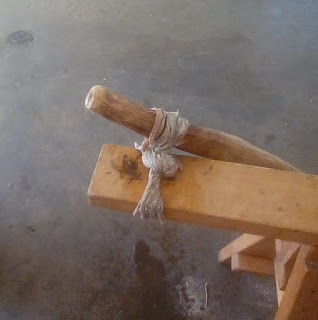Home Made Practice Arrow Tips (for wood shafts).
Antler is tough, like plastic, but tougher and wont pollute so you can loose the tip.
You simply cut a small section from a tine, stem, or paddle, vice it, drill a hole with a 3/8ths if it's a big peice or 9/32 for a smaller one, to accommodate the slightly tapered wood shaft end. If the shaft is too narrow for the tip and the tip slides about, still put a short taper on the end of the wood shaft, then put a paper or cotton rag over the end before ramming both into the antler hole.
It's optimal if you don't make a hole through the piece of antler and stop the drill just before breaking through the other side. If you do however, bend a cord of wire with some pliers into a U with a tail. Fit to the top of the shaft then push the hollowed antler tip over the cord and shaft. Ram down until quite snug.
Mud, snow, and soft ice will latch onto the tips and keep them on retrieval; the solution to this is to drill a small hole through the head and shaft and slip an iron wire through.
Use an angle grinder or other filing tool to round out the bulbed antler at the tip of your arrow. I make a batch using pliers and round before adding to the shaft. The base should be tapered to the rim of the hole so that the tip won't catch and you loose it while retrieving. Don't make them too heavy; just heavy enough to take some hard hits and keep the weight forward on the shaft.
Pay attention to symmetry and aerodynamics when using the angle grinder to shape the antler head (or any arrow head).
In the field, you will find parking and open space for daily practice in old quarries which are full of stone. Antler will not stand reapeat strikes to hard stone. Clearing the big stones from a hill is a first step. If you practice where there are many stones, find a great tip with brass discards, which can usually be had in these quarries - these are fine for small game too.
Another great choice for a home made tip is to use the front heavy natural shaft you already have - because your shoot is shot base of the tree forward - then simply reduce the wood slightly to accommodate a small ring of iron or copper, as shown in the following examples. The point, weather it be a practice arrow shaft or spear is to keep a tight ring around the tip to prevent the wood from mushrooming and splitting on repeated strikes.
Another easly procured practice tip source is to coil a section of marker flag wire with a pair of pliers.





